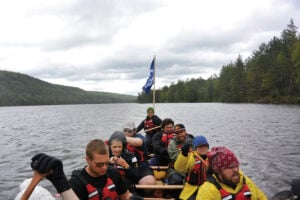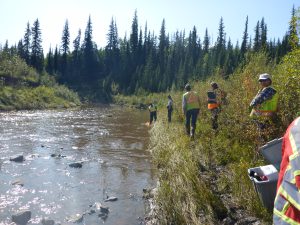
People & Culture
With each stroke, a breath
How a journey through the Great Lakes helped reshape my relationship with water after the loss of my father
- 3036 words
- 13 minutes
This article is over 5 years old and may contain outdated information.
Science & Tech

When Amelie Janin lifts a shovelful of mud out of a creek at Keno Hill, a former Yukon silver mine site, she knows it will be full of unusual bacteria that have a peculiar diet and a promising future. They eat heavy metal compounds, and they’re the latest word in mine cleanup.
Mine drainage water can contain toxic heavy metals such as arsenic and cadmium. When it sinks into the ground or runs into creeks and rivers it can cause serious environmental contamination. Janin, a water chemist at the Yukon Research Centre at Yukon College, is harnessing the unique microorganisms to help treat this problem. Her team’s project started after four resource companies approached her for help with environmental protection.
For her experiments Janin uses sulphate-eating bacteria that she finds in mud under mine drainage water, which is laden with sulphates. In her lab she places the microorganisms in bioreactors containing gravel or other surfaces on which they can grow. The bioreactors — which at full size would be trenches or ponds — act like filters: as gravity pulls the contaminated water through, the tiny creatures consume the sulphates and convert them into harmless sulphides. The heavy metals precipitate out.
“We’ve had very exciting results for removal of metal,” says Janin. “The process is very efficient; we’re working on how to control it and make it more reliable. The challenge is to adapt these biological technologies to cold temperatures.”
Using bacteria is inexpensive as well as effective, Janin says. “The passive water treatment we’re developing costs much less than using machinery. Mining companies support the development of such technology as they are responsible for water treatment over the life-cycle of a mine, including closure.”
Another bonus of this method is its longevity. Even if a mine site has been abandoned, the toxic contaminants must still be cleaned up, and the Yukon Research Centre team’s process can potentially keep operating for a hundred years. “Bacteria,” says Janin, “don’t go bankrupt.”


Are you passionate about Canadian geography?
You can support Canadian Geographic in 3 ways:

People & Culture
How a journey through the Great Lakes helped reshape my relationship with water after the loss of my father

People & Culture
For generations, hunting, and the deep connection to the land it creates, has been a mainstay of Inuit culture. As the coastline changes rapidly—reshaping the marine landscape and jeopardizing the hunt—Inuit youth are charting ways to preserve the hunt, and their identity.

Environment
Many of Canada’s 25 watersheds are under threat from pollution, habitat degradation, water overuse and invasive species

Environment
How much do you know about Canada’s water — where it comes from and how it’s used?